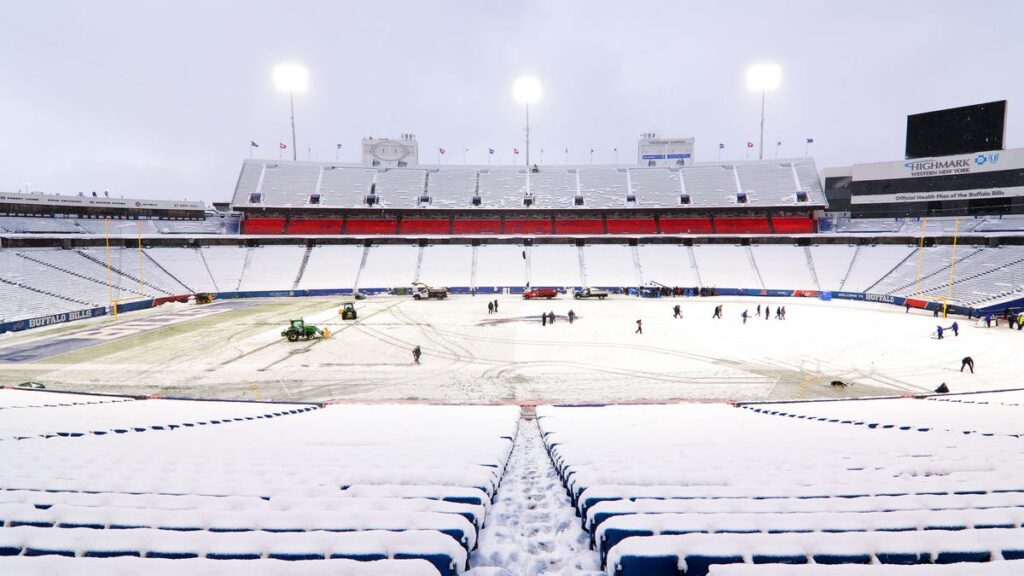Snow is as omnipresent in Buffalo as rivers are in Pittsburgh. Buffalonians are accustomed to sheets of snow piling up on the city’s roads and sidewalks. Highmark Stadium was supposed to host the opening playoff contest of 2024 until Mother Nature intervened, despite the fact that the city has experienced more extreme storms that were deemed safe for a football game to be played in.
There’s a long history of Buffalo Bills games being played in unbearable conditions. Two years ago, the New England Patriots played the Bills in a windtunnel. The Bills lost that one 14-10; so much for a competitive advantage. For some, the postponement of yet another Bills contest due to inclement weather has strengthened the case for the construction of a dome over the Bills’ planned new state-of-the-art stadium. That facility won’t be ready until the 2027 season, however, the Buff prides itself so much on its Arctic weather that they punted on adding a retractable dome to protect players and fans from the elements. The better for fans to jump through flaming tables, shirtless, in subzero temps.
In the wake of New York Gov. Kathy Hochul canceling last Saturday’s Steelers-Bills matchup, upset Yinzers and Buffalonians went stark raving mad questioning when the city got so soft as to cancel a playoff game over a few feet of snow in one of America’s coldest cities.
Maybe it’s pseudo-criticism of how soft America has become or maybe we took football too seriously, which is itself a commentary on America. Even more indicative of how we operate is that for capitalistic reasons, the city of Buffalo decided to chip in $850 million towards the $1.4 billion bill on the NFL’s first open air stadium since the San Francisco 49ers’ Levis Stadium opened in 2014. Nevermind that whatever so-called competitive advantage the Bills gain from the elements probably disappears against a team like the Steelers, who play just a few hours away in The Stadium Formerly Known as Heinz Field, itself an open-air monstrosity that not only lacks a roof, but has one end exposed to an often icy river.
In reality, a cover over the stadium wouldn’t have avoided the postponement of the Bills-Steelers Wild Card tilt. Stadium domes don’t make streets accessible or improve driving visibility around Orchard Park for over 70,000 people. The under-construction New Highmark Stadium (irony: the company that owns naming rights to the Bills’ home field is a healthcare conglomerate based in…you guessed it: Pittsburgh) doesn’t need a dome, but one over the entire city of Buffalo would be a better use of taxpayer funds.
Hear me out. Of course, they can still open it during game days. But during weather-related states of emergency, it would be a more worthwhile investment. The only obstacle is Buffalo’s willingness to dole out a few hundred billion for a city dome, disassociating its identity from blizzards 11 months out of the year and some extreme NIMBYism. The few billionaires who do business out of Buffalo subsidizing, say, 80 percent of the costs feels like a fair exchange.
If the Buffalo taxpayers ar going to fork over billions towards an open-air stadium in a city so prone to blizzards that it can’t reliably schedule an NFL playoff game, then upstate New York might as well get something cutting edge out of it. If a few hundred-billion isn’t too high of a bill, how about a compromise then? Start small and build a dome that extends to the parking lots. Construct an above ground tunnel system for the fans to reach the arena in. The value of real estate under the Buffalo Dome would skyrocket.
It’s a costly bet, but it’d get more usage than a mere domed stadium and would end the barrage of postponements throughout Buffalo. That alone makes it a worthwhile investment. The tallest building in Buffalo is the Seneca One Tower measuring 500 feet, which presents a bit of an obstacle, but one that some engineer, somewhere, could figure out.
Buffalonians don’t have to live like this for the sake of a competitive advantage.



